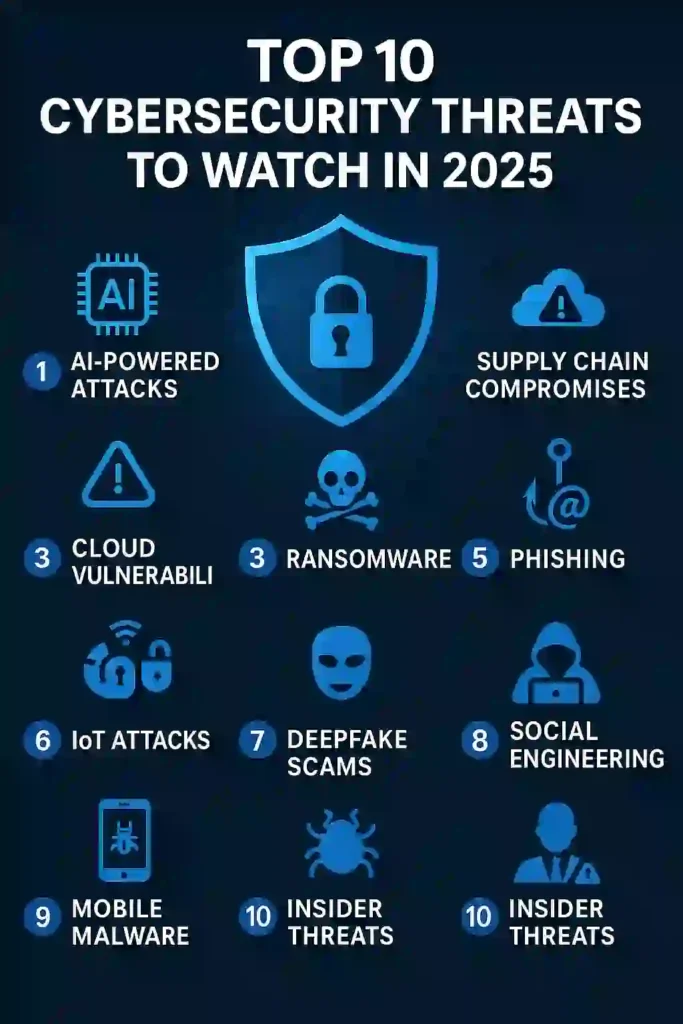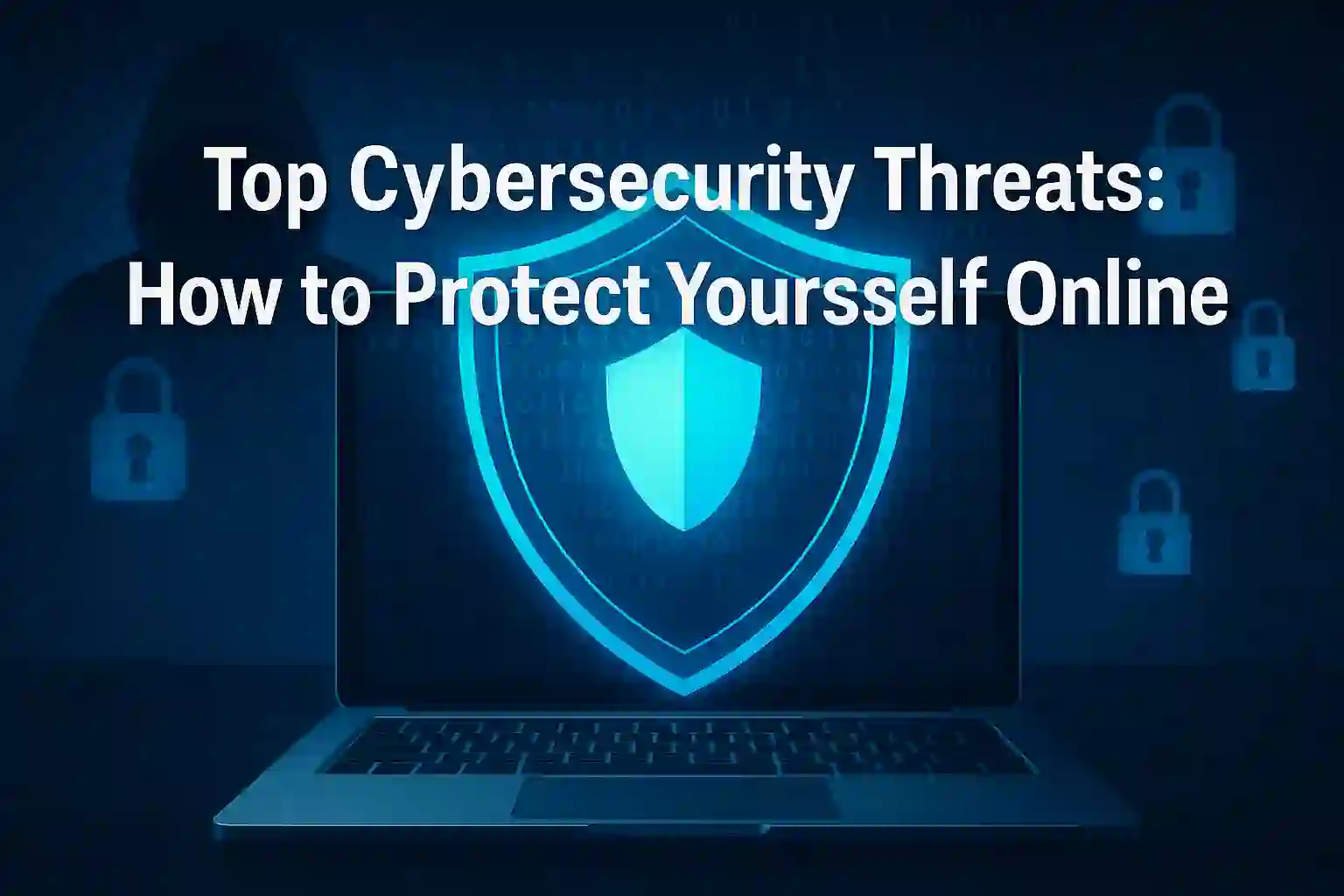Top 10 Cybersecurity Threats to Watch in 2025
As we get closer to 2025, the world of cybersecurity is getting more complex. Are companies ready for the new threats that could harm their digital safety?
The year 2025 will see a rise in cybersecurity challenges. With new tech like AI, 5G, and IoT, the risk area is growing. It’s key for companies to keep up with the latest dangers.

Table of Contents
ToggleThis article will look at the top cybersecurity threats for 2025. We’ll also share tips on how to fight them. This way, companies can take steps to protect themselves.
Key Takeaways
- Understanding the evolving cybersecurity landscape in 2025
- Identifying the top cybersecurity threats
- Learning how to mitigate emerging threats
- Staying ahead with proactive security measures
- Adapting to the changing attack surface
The Evolving Cybersecurity Landscape of2025
New threats and tech advancements will change the cybersecurity world in 2025. As we rely more on digital tech, strong cybersecurity is key.
Why Cybersecurity Will Matter More Than Ever
In 2025, cybersecurity will be more critical than ever. This is because cyber threats are getting smarter. Cybercriminals are using artificial intelligence and machine learning for more complex attacks.
The table below shows why cybersecurity is changing:
| Factor | Description | Impact |
|---|---|---|
| Technological Advancements | Rapid development of new technologies | Increased vulnerability to new types of attacks |
| Cybercriminal Sophistication | Growing use of AI and ML by cybercriminals | More targeted and complex attacks |
| Digital Dependency | Increasing reliance on digital technologies | Greater impact of cyber breaches |
How Organizations Can Prepare for Emerging Threats
To face 2025’s threats, organizations need a proactive cybersecurity plan. This includes:
- Investing in advanced security tech, like AI-driven systems
- Using zero-trust architectures to fight insider threats
- Keeping up with the latest cybersecurity trends 2025 and threats
By understanding the cyber threats landscape 2025 and acting early, organizations can protect against future threats.
READ ALSO – Top 11 Most Common iPhone Problems and How to Fix Them
Top10 Cybersecurity Threats to Watch in2025
The top 10 cybersecurity threats for 2025 are diverse and serious. They can harm both businesses and individuals. These threats are real and could cause a lot of damage.
Overview of the Most Critical Digital Security Risks
The digital world is getting more complex, with new threats appearing as tech advances. Key risks include advanced ransomware, AI-driven attacks, and supply chain compromises. These threats are dangerous because they are often sophisticated and hard to spot.
It’s important to understand these emerging cyber risks. This knowledge helps in creating effective ways to fight them. Companies need to keep up with the latest security issues and act quickly to protect themselves.
How These Threats Will Impact Businesses and Individuals
The effects of these threats can be huge. Companies might lose money, suffer damage to their reputation, and face legal problems. People could have their personal info stolen, leading to identity theft and other problems.
To fight these risks, both businesses and people need to know about the dangers. They should use strong security steps like multi-factor authentication and regular software updates. It’s also key to teach employees about good cybersecurity habits.
By staying alert and taking action, companies can lower their risk. This way, they can protect themselves from the top 10 cybersecurity threats of 2025.
Threat #1: Advanced Ransomware and Extortion Tactics
In 2025, cybercriminals will use advanced ransomware and extortion tactics more than ever. This will be a big threat to companies all over the world. Ransomware is getting more common and causing a lot of damage.
The evolution of Ransomware-as-a-Service (RaaS) models has made it simpler for hackers to start ransomware attacks. RaaS offers tools and services for malware, making it easier for new hackers to join.
Evolution of Ransomware-as-a-Service (RaaS) Models
RaaS has changed the ransomware world. It’s like a subscription service that lets anyone start ransomware attacks. This has led to more attacks and they are getting smarter.
- RaaS platforms offer tools and services for malware.
- These platforms make it easy for new hackers to start ransomware attacks.
- The rise of RaaS has increased the number and complexity of ransomware attacks.
Multi-Layered Extortion Strategies
Cybercriminals are now using multi-layered extortion strategies to get more money. They encrypt data and threaten to release sensitive information unless they get paid.
To fight these threats, companies need to use robust cyber defense strategies. This includes keeping software up to date, educating employees, and having good backup and recovery plans.
READ ALSO – Quantum Computers in 2025: Power, Potentia and Challenges
Threat #2: AI-Powered Cyber Attacks
AI-driven attacks are changing the cybersecurity world. It’s key for companies to update their security. Cybercriminals use AI and machine learning to make threats bigger and more complex.

Machine Learning for Automated Vulnerability Discovery
Cybercriminals use machine learning to find software and system weaknesses. This makes them better at finding and using these weaknesses than before.
- Automated Scanning: AI tools scan big networks and systems for vulnerabilities.
- Predictive Analysis: Machine learning predicts where and how attacks will happen, helping to prevent them.
- Enhanced Phishing: AI makes phishing emails and messages more believable, making these attacks more successful.
Defensive AI Strategies and Countermeasures
To fight AI-powered cyber attacks, companies need to use defensive AI. This means using AI and machine learning to boost security.
- AI-Driven Security Solutions: Use AI security tools that can spot and handle threats quickly.
- Continuous Learning: Make sure AI systems keep learning and updating to stay ahead of threats.
- Human-AI Collaboration: Use AI and human insight together to better find and deal with threats.
Understanding AI-powered cyber attacks helps companies get ready to defend against them. It’s important to keep up with the latest threats and update security plans.
Threat #3: Supply Chain and Third-Party Compromises
One of the big cybersecurity threats in 2025 is supply chain and third-party attacks. As companies use more outside vendors, the chance for hackers to get in grows. This makes it easier for cybercriminals to find new ways to attack.
Supply chain attacks have become more common. These attacks happen when hackers get into a trusted vendor’s system to reach the main company’s network. This can lead to big problems like data theft and service disruptions.
Software Supply Chain Infiltration Techniques
Cyber attackers are getting better at sneaking into software supply chains. They use:
- Malware in software updates or patches
- Open-source software component hacks
- Vulnerabilities in third-party libraries
Vendor Risk Management Approaches are key to fighting these risks. Companies need to check their suppliers’ security, control who has access, and watch what third parties do.
Vendor Risk Management Approaches
Good vendor risk management includes several steps:
| Strategy | Description | Benefits |
|---|---|---|
| Thorough Security Assessments | Do detailed security checks on third-party vendors | Finds possible weak spots |
| Stringent Access Controls | Keep tight control over who sees sensitive info | Less chance of data leaks |
| Continuous Monitoring | Keep an eye on what third parties are doing | Can spot and act on threats fast |
By using these methods, companies can shield themselves from the dangers of supply chain and third-party attacks in 2025
READ ALSO – How to Avoid Scams on Mobile Payment Apps in 2025
Threat #4: Quantum Computing Threats to Encryption
In the near future, quantum computing will challenge our current cryptographic systems. As quantum computing technology advances, the risk of breaking conventional encryption methods increases. Organizations must stay informed about developments in quantum computing and begin exploring quantum-resistant cryptographic solutions.
Vulnerable Cryptographic Standards
Current cryptographic standards, such as RSA and elliptic curve cryptography, are vulnerable to quantum computing threats. Quantum computers can potentially factor large numbers and compute discrete logarithms much faster than classical computers, rendering these encryption methods insecure.
The impact on cybersecurity risks in 2025 will be significant if we don’t adapt. Many of our current encryption protocols will be rendered obsolete, compromising the security of online transactions and communication.
Quantum-Resistant Algorithm Implementation
To mitigate these risks, organizations are turning to quantum-resistant algorithms, also known as post-quantum cryptography. These algorithms are designed to be secure against both classical and quantum computers, ensuring long-term data protection.
Implementing quantum-resistant algorithms requires careful planning and execution. Organizations should start by assessing their current cryptographic infrastructure and identifying areas that need to be upgraded.
| Cryptographic Algorithm | Current Security | Quantum Resistance |
|---|---|---|
| RSA | High | Low |
| Elliptic Curve Cryptography | High | Low |
| Lattice-based Cryptography | High | High |
As shown in the table, lattice-based cryptography is one of the promising quantum-resistant algorithms. Organizations should consider adopting such algorithms to future-proof their encryption.
Threat #5: Advanced Social Engineering with Deepfakes

Deepfakes are changing the game in social engineering, opening up new ways for cybercriminals to attack. As deepfake tech gets easier to use, the danger it poses to businesses in 2025 is growing. This makes it a big worry for companies everywhere.
Audio and Video Deepfake Business Email Compromise
Deepfakes are being used in Business Email Compromise (BEC) attacks in scary ways. Hackers are making fake audio and video messages that seem real. They pretend to be top bosses or trusted friends. These tricks can fool employees into sharing secrets or doing things that put security at risk.
Key characteristics of deepfake BEC attacks include:
- Highly convincing audio and video content
- Impersonation of executives or trusted individuals
- Requests for sensitive information or actions
Training Employees to Recognize Sophisticated Fakes
To fight deepfake social engineering, companies need to teach their teams well. They should learn about deepfake BEC scams and how to spot them. This training helps employees stay alert and avoid falling for these tricks.
| Training Focus | Description | Benefits |
|---|---|---|
| Recognizing Deepfakes | Training employees to identify possible deepfakes by looking for odd audio/video quality, context, and behavior | Employees become more alert to deepfake threats |
| Verification Processes | Setting up extra checks for sensitive requests | Less chance of falling for BEC scams |
| Reporting Suspicious Activity | Teaching employees to report odd emails or messages | Fast action on threats, less damage |
By using smart tech and keeping an eye out, companies can lower their risk from deepfake social engineering attacks.
READ ALSO – TorrentGalaxy vs 1337x vs Pirate Bay: Which is Best?
Threats #6: Emerging Cybersecurity Challenges
As we near 2025, companies face many new cybersecurity threats. These threats need quick action and smart steps to stay safe. The fast-changing tech world brings new dangers that can get past even strong defenses.
Threats #7: 5G and Edge Computing Vulnerabilities
The launch of 5G and edge computing brings big benefits like quicker data and less delay. But, they also bring new security risks. 5G security is a big worry because of its complexity and bigger attack area.
Edge computing, which handles data near its source, cuts down on delay but also brings new dangers. It’s key to keep edge devices and networks safe to stop data leaks and cyber attacks.
Threats #8: IoT Botnet Attacks and Smart Device Exploitation
The Internet of Things (IoT) is growing fast, with more devices linking up. This connection brings many benefits but also raises the risk of IoT security breaches. IoT botnet attacks, where many IoT devices are hacked for attacks, are a big threat.
It’s up to both makers and users to keep IoT devices safe. This includes regular updates, strong passwords, and dividing networks to lower risks.
Threats #9: Cloud Security Misconfigurations
More companies are moving to the cloud, making cloud security more critical. Mistakes in cloud settings can cause data leaks and let unauthorized people in.
Companies need to take strong steps to secure their cloud data. This includes regular checks, access controls, and encryption to keep data safe.
Threats #10: State-Sponsored Advanced Persistent Threats (APTs)
State-sponsored APTs are complex cyber attacks backed by governments. These attacks aim to stay hidden for a long time, gathering info or causing trouble.
Companies must stay alert to these threats. They should use advanced detection systems, do regular security checks, and promote a strong cybersecurity culture.
In summary, the cybersecurity challenges of 2025 need a proactive and wide-ranging security strategy. By knowing these threats and taking strong security steps, companies can protect themselves against the changing cyber threat world.

Conclusion: Building Cyber Resilience for the2025 Threat Landscape
As we near 2025, the world of cybersecurity is getting more complex. Companies need to build cyber resilience to handle this changing threat landscape.
Keeping up with new cybersecurity trends and using advanced security tools is key. It helps organizations stay ahead of threats. Also, creating a culture of cybersecurity awareness is vital to protect valuable assets.
Good cybersecurity strategies help organizations manage risks and handle incidents well. As threats keep changing, focusing on cyber resilience is critical. It helps businesses and individuals protect their digital world.
In 2025, strong cybersecurity is more important than ever. By being proactive in cybersecurity and focusing on resilience, companies can face the 2025 threats head-on.
FAQ
What are the top cybersecurity threats to watch in 2025?
In 2025, watch out for advanced ransomware and extortion tactics. Also, AI-powered cyber attacks, supply chain and third-party compromises, and quantum computing threats to encryption are expected. Advanced social engineering with deepfakes is another threat.
How can organizations prepare for emerging cyber threats in 2025?
To prepare for 2025, adopt proactive security measures. Use AI-driven threat detection and zero-trust architectures. Stay updated on cybersecurity trends and invest in advanced security technologies.
What is the impact of AI-powered cyber attacks on businesses and individuals?
AI-powered cyber attacks can harm businesses and individuals a lot. They can automate and scale malicious operations. This makes it easier to bypass traditional security and can lead to big financial losses and damage to reputation.
How can organizations mitigate the risks associated with supply chain and third-party compromises?
To reduce risks from supply chain and third-party compromises, do thorough security assessments. Implement strict access controls and continuously monitor third-party activities.
What are the potentially risks associated with quantum computing threats to encryption?
Quantum computing threats to encryption could break conventional encryption methods. This could compromise sensitive data and lead to significant financial losses and damage to reputation.
How can organizations protect themselves against advanced social engineering with deepfakes?
To protect against advanced social engineering with deepfakes, invest in security awareness training. Educate employees about phishing techniques. Implement robust verification processes to detect and prevent deepfake attacks.
What are the emerging cybersecurity challenges associated with 5G and edge computing?
5G and edge computing bring new cybersecurity challenges. They expand the attack surface, leading to significant security risks and threats to businesses and individuals.
How can organizations build cyber resilience in the face of emerging threats?
To build cyber resilience, stay informed about cybersecurity trends. Invest in advanced security technologies. Foster a culture of cybersecurity awareness. This helps stay ahead of threats and protect valuable assets.






